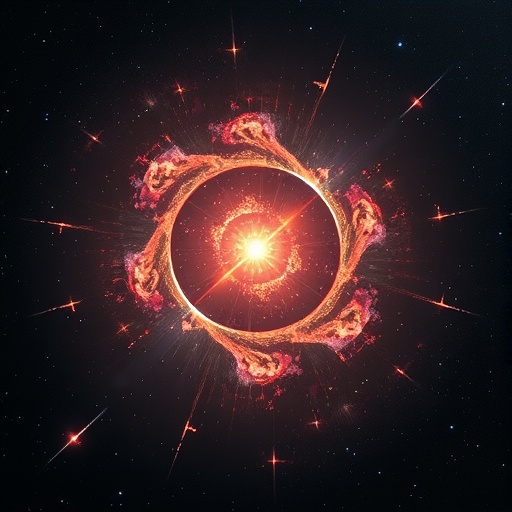In the cosmic theater of galaxy evolution, quasars stand as some of the most luminous and energetic actors, their brilliance powered by gas inexorably spiraling into the depths of supermassive black holes. These cosmic beacons, often ignited in the tumultuous aftermath of galaxy mergers, not only illuminate the distant Universe but also profoundly influence the evolutionary pathways of their host galaxies. Despite longstanding theoretical consensus on the pivotal role of major mergers in sparking quasar activity and the consequential feedback effects on surrounding gas, empirical evidence capturing these phenomena in action remains scarce. In a groundbreaking study recently published in Nature, a team of astronomers unveils direct observational insight into the dynamic interplay between a quasar and its merging companion galaxy at a redshift of approximately 2.7, shedding new light on the intimate mechanisms by which quasar radiation transforms galactic environments.
This discovery resonates powerfully with theoretical predictions of quasar feedback mechanisms, underscoring the complex, multi-scale processes that regulate galactic growth. It adds a crucial piece to the puzzle of how supermassive black holes and their host galaxies co-evolve across cosmic epochs. Crucially, it demonstrates that the destructive hand of quasar radiation is not confined to the host galaxy itself but can extend its reach to influence companion galaxies in close proximity during the merger process. In this way, the interplay between these titanic cosmic bodies transcends simple gravitational interactions, embedding radiative transfer and gas physics at the core of galaxy transformation narratives.
The implications of these findings extend to our broader understanding of galaxy formation models. While galaxy mergers have been heralded as a primary mechanism for triggering active galactic nuclei, the detailed pathways through which quasar feedback sculpts the interstellar medium remain a topic of intense debate. Observations to date have typically highlighted large-scale outflows and the mechanical impact of energetic winds; however, these results reveal instead a subtler, microphysical reconfiguration within the gas phase. By demonstrating that quasar radiation can fragment molecular reservoirs into these minuscule, dense units incapable of sustaining star formation, the study refines theoretical frameworks to incorporate the microenvironmental consequences of active nuclei.
Moreover, the dense, cloudlet-like structures identified in this study challenge existing paradigms on the lifecycle and stability of molecular clouds in extreme environments. Traditionally, molecular clouds are considered to be relatively large-scale, turbulent entities that fragment to spawn stars. The newfound existence of ultracompact molecular clumps under intense radiation pressure invites a reevaluation of cloud formation and survival criteria in quasar-illuminated regions. It suggests that the apparent suppression of star formation in such environments may result from an alteration in cloud morphology and density distribution rather than outright gas removal, highlighting the diverse modes of feedback operating in galaxies.
Technological advancements in submillimeter and millimeter wave spectroscopy were instrumental in achieving these insights. By resolving absorption features against the quasar’s luminous background, the team circumvented the spatial resolution limits that impede direct imaging of such compact structures at high redshift. This methodological innovation opens vistas for future studies aiming to probe the microphysics of gas in similarly extreme contexts, potentially across different galaxy types and evolutionary stages. Understanding how radiation-driven processes modulate star formation is especially crucial given the mounting evidence that feedback shapes the color, morphology, and mass assembly of galaxies throughout cosmic history.
The dramatic changes observed in the molecular gas of the merging system reflect the intimate coupling between black hole activity and galactic ecosystems on previously inaccessible scales. It is clear that the quasar’s radiative output acts as a transformational agent, compressing and exciting the molecular gas while simultaneously preventing its collapse into stars, thus regulating the fate of baryonic matter during a critical phase of galaxy coalescence. Consequently, the study provides empirical grounding to models positing that quasar feedback operates not only on large galactic scales but also exerts pivotal influence at the cloud scale, altering star formation efficiency through the reconfiguration of gas properties.
Further research will be needed to establish how ubiquitous such phenomena are across the quasar population and how the balance between negative and positive feedback evolves with time and environmental conditions. Understanding the longevity and eventual fate of these dense molecular cloudlets—whether they dissipate, are reincorporated into the galactic medium, or survive to fuel delayed star formation—is key to linking quasar phases with subsequent galaxy evolution. Moreover, exploring the detailed interplay between radiation pressure, gas kinematics, and molecular chemistry in these environments will refine our grasp of galaxy-scale feedback cycles.
In conclusion, this work represents a remarkable stride forward in astrophysical research, bridging observational gaps and providing a vivid demonstration of how quasar radiation fundamentally transforms the interstellar medium in merging galaxies. It brings us closer to unraveling the complex symbiosis between supermassive black holes and their host galaxies, revealing that quasar feedback’s role is as intricate as it is profound. As observational capabilities continue to push boundaries, the door is now open for a new generation of studies probing the cosmic crucibles where galaxies and black holes shape one another’s destinies.
Subject of Research:
Quasar-driven transformation of molecular gas in a major galaxy merger at redshift ~2.7
Article Title:
Quasar radiation transforms the gas in a merging companion galaxy
Article References:
Balashev, S., Noterdaeme, P., Gupta, N. et al. Quasar radiation transforms the gas in a merging companion galaxy. Nature (2025). https://doi.org/10.1038/s41586-025-08966-4
Image Credits:
AI Generated
Tags: astrophysical implications of quasar luminositycosmic events and galaxy formationempirical evidence of quasar feedbackgalaxy evolution and quasar activitygas dynamics in merging galaxiesgravitational interactions in cosmic mergersmerging galaxies and black holesobservational study of quasarsquasar radiation impact on galaxiesredshift observations of quasarsstar formation in merging galaxiessupermassive black holes in mergers





